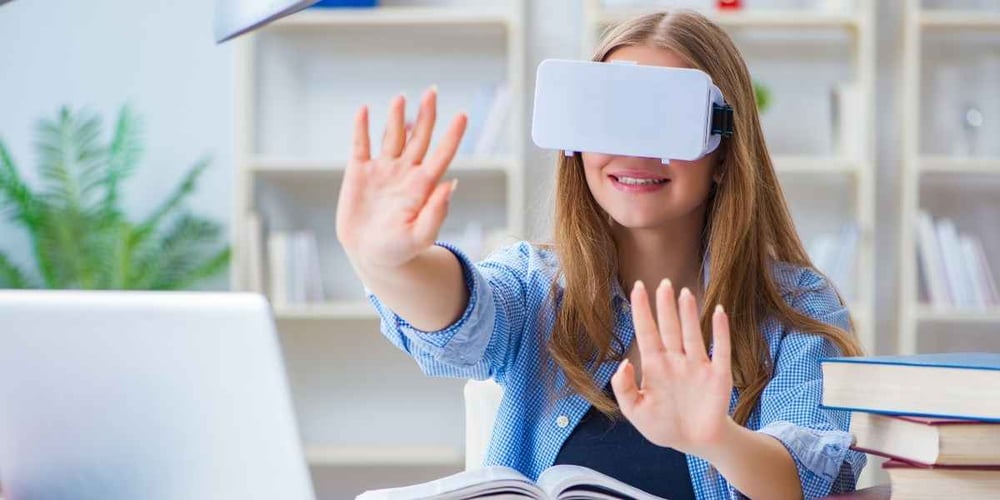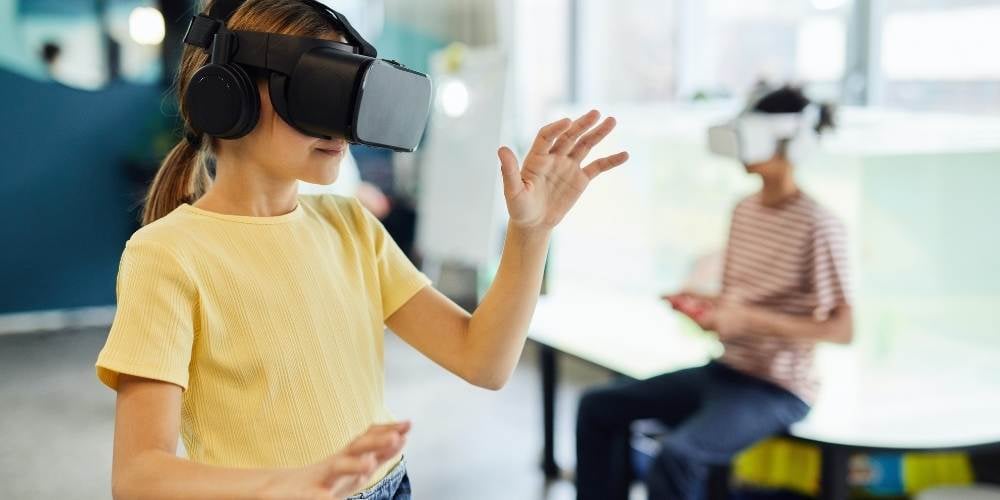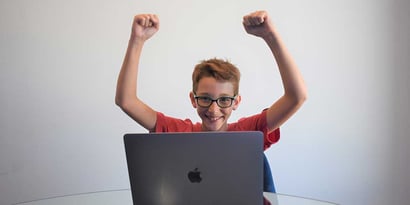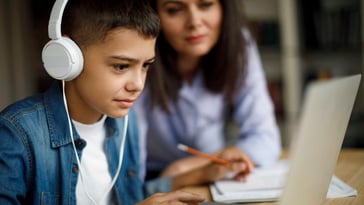Contents
- What is virtual reality?
- How is VR used in education?
- What is a VR classroom?
- How do you use VR in the classroom?
- Are virtual reality headsets bad for the eyes?
- Why virtual reality in education?
- Why is virtual reality the future of education?
- How virtual reality helps mental health in students
Digital learning is becoming the norm in many classrooms. As a result, learning with Virtual Reality (VR) is becoming increasingly popular in modern education. We can understand why you might be sceptical about this new technology and how it affects your child’s digital wellbeing. Or perhaps you are just curious to know how VR in education will benefit your child.
In this article, with the expertise of Simon Luxford-Moore, the head of E-learning at the ESMS schools in Edinburgh and a VR pioneer, we answer all your questions around VR in education. Supported by real evidence from classroom lessons, we reveal how virtual reality can positively transform the way students learn.

What is virtual reality?
Virtual Reality (VR) refers to a computer-generated simulation in which a person can interact within an artificial three-dimensional environment using electronic devices – usually special goggles with a screen.
In this simulated artificial environment, the user is able to have a realistic immersive experience.
How is VR used in education?
VR in education is typically used in a way where students experience different environments from all over the world, without having to leave the classroom. From the grandeur of the Pyramids in Egypt to the adventurous safaris of Maasai Mara, VR allows students to travel the globe from their desks. 🌍
The technology most commonly used in VR education is known as 360VR.
Once real-world locations are captured with specialist cameras and equipment, the footage is then produced into 360VR content.
What is VR classroom?
A VR classroom is one where VR content can then be viewed through VR headsets or projected onto walls. Students are transported to the world of the VR content being showcased.
In a VR classroom, students have the chance to experience locations that would otherwise be very difficult to access. In this way, VR can open up a whole new world of possibilities to teachers and schools.
How do you use VR in the classroom?
VR is usually used in schools through VR headsets and immersive classrooms.
-
Immersive classrooms
An immersive classroom is one where images are projected onto the internal walls of the room. In this virtual environment, students are transported to a different place or space while still being able to interact with their classmates.
Immersive classrooms are suitable for all students as they allow them to enjoy VR while still being grounded in the familiarity of the classroom. Unlike VR headsets, where students will find the classroom completely disappear while they experience the content by themselves. This can make VR headsets uncomfortable or difficult for some students to use.
-
VR headsets
Educators have found VR headsets a logistically viable and cost-effective way to introduce VR in classrooms. These are usually standalone headsets that don’t need to be connected to an external digital device. Though teachers do need prior training to facilitate their use in the classroom.
The added advantage that VR headsets have over immersive classrooms, is that they provide students with a more ‘real-life’ experience. One that students will remember even after they’ve removed their headsets.
Luxford-Moore explains how his teachers have incorporated VR in their lessons:
-
VR in Language
One of Luxford-Moore’s favourite examples of VR in education is through creative writing. Suppose students need to write a spooky story based in the middle of the night, deep in the dark woods. Hardly any of them would have experienced such an environment and it wouldn’t be safe for them to either.
That’s when VR comes to the rescue.
VR allows students experience the atmosphere of being surrounded by pine trees, hearing the cries of owls and even watching a grizzly bear walking up towards them, and roar straight into their face. 🐻
Luxford-Moore also found that in young students, the experience of VR allowed them to use emotive vocabulary; like describing the warm breath of the bear on their necks. Something they would have found harder to imagine if they hadn’t experienced the stimuli of the woods in the safe environment of VR.
-
VR in History
History and geography are some of the most popular ways VR in education can be used, as it helps break barriers of space and time.
In one of their lessons, Luxford-Moore’s students experienced a virtual tour of Mecca. The students had the ability to turn their heads and see the sheer scale and size of the Kaaba and over nine million people around them.
“VR added so much more empathy and understanding in the students towards this religious experience, [Mecca] than just reading and writing about it,” says Luxford-Moore. “VR makes the big world a smaller place.”
-
VR in Science and Maths
From being able to travel inside the body’s blood system for a biology lesson to soaring through the milky way to learn about planets, VR makes sure students completely immerse themselves in science.
Even geometry becomes fun as students explore shapes and sums in a 3D format of VR or augmented reality (AR).
It’s true that not everything in the curriculum needs to be taught through VR. Luxford-Moore says that teachers must choose VR in education when they feel it can make a difference in the lesson. VR will only be effective in learning when it is not the focus of the lesson but used as a supportive resource.
Are virtual reality headsets bad for the eyes?
Luxford-Moore feels that like any technology if used in moderation, VR headsets are not bad for the eyes or overall student health. 👀
He further recommends that in a one-hour lesson, headsets are not used for more than 15 minutes. And even then five minutes at a time, so students can take breaks and not be overwhelmed by too much digital learning. He adds that VR is often mistaken for gaming. Though, unlike gaming, in VR students are not focusing on the screen cross-eyed or with their faces just inches away from the screen.
“VR is not very different from going to the movies or viewing the world with binoculars,” says Luxford-Moore. “So I would actively encourage parents not to be frightened of it if they hear that their children are using VR in school.”
Luxford-Moore recommends a headset with “40-60 frames per second”. Those are the ones that are “too slow to trigger any reactions”, even in epileptic students.
Why virtual reality in education?
VR in education has many learning benefits:
-
Experiential learning
VR allows students to learn through experience, which is the most powerful way of gaining knowledge. Studies have shown that when using immersive technology learning retention rates can be as high as 75%.
Being able to see and experience extraordinary locations and cultures from around the world, sparks students’ intellectual curiosity, creativity and imagination.
-
Inclusive learning
“Virtual reality offers experiential learning,” says Luxford-Moore head of E-learning at the ESMS schools in Edinburgh and a VR pioneer. “It allows children to gain from a number of mediums – visually, auditorily and kinesthetically with their learning.”
This way, VR in education caters to a wide variety of learning styles. It becomes particularly beneficial for students with learning difficulties, who find traditional classroom teaching challenging. VR also encourages independent learning, where students can absorb the content at their own pace and time.
VR is also financially inclusive for students. Through VR, money no longer remains a barrier for students to travel the globe and take virtual field trips with their peers. 👏
-
Interactive learning
Experiencing a whole new reality is a stimulating experience. Especially if the experience is a shared one. VR in education stimulates students to share their thoughts and opinions about their viewing experience with each other. This encourages the building of soft skills like communication, critical thinking and analysis.
-
Engaging learning
All students have particular subjects that they struggle with. VR with its life-like experience and interactive dimensions makes learning engaging and playful.
A topic like climate change can feel hard for students to grasp. Yet, if they are transported to the arctic through VR, they will feel a connection with the environment. This immersive experience will enable them to truly understand the impact of climate change. 💪
-
Mentor learning
The pandemic brought online learning to the forefront of education. With its immersive experience, VR in education can make access to mentors and educational courses across the globe even more impactful for students.
At GoStudent, we provide tailored learning programmes for your child from our community of highly qualified tutors. Book your free trial lesson here. 🚀
Why is virtual reality the future of education?
According to studies, virtual reality and augmented reality have the potential to boost the global economy by £1.4 trillion by 2030. While augmented reality is forecasted to provide the biggest benefits to global GDP, accounting for £985 million of that total. Apart from the many pedagogical benefits of VR, the technology is also extremely supportive when it comes to filling in learning gaps.
How virtual reality helps mental health in students
As the pandemic continues, many students are still struggling with switching from remote learning to classroom learning. Social anxiety and children refusing to go to school have been some common challenges.
Luxford-Moore says it’s true that VR can never replace face-to-face learning. Yet VR with its ability to transport students to any place can give them “a better connection between homeschooling and classroom learning.”
If your child’s school is using VR for teaching, we’d recommend you embrace this technology. Rest assured that VR will only enhance your child’s learning, making lessons a memorable and exciting experience.👊









